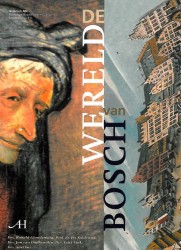Van Oudheusden 2001a
“Het cultureel klimaat in ’s-Hertogenbosch in de vijftiende en zestiende eeuw” (Jan van Oudheusden) 2001
[in: Jan van Oudheusden and Aart Vos (eds.), De Wereld van Bosch. Historisch ABC – Archeologie Bouwhistorie en Cultuur ’s-Hertogenbosch – volume 4, Adr.Heinen, ’s-Hertogenbosch, 2001, pp. 50-73]
Van Oudheusden reports some general facts about the cultural climate in ’s-Hertogenbosch circa 1500: the influence of the Burgundian court and the religious institutions as patrons of the arts.
- There was no court in ’s-Hertogenbosch but the Burgundian and Hapsburg princes regularly visited the city and brought it into contact with the culture of their court.
- During the winter visit of 1504-1505 Maximilian of Austria’s wife, Bianca Sforza, stayed with Bosch’s neighbour, Lodewijk Beys. Maximilian and Philip the Fair stayed with the Dominicans. In September 1504 Philip the Fair ordered a Last Judgment from Bosch and in 1505 Philip ordered a large St Anthony triptych from an unknown painter, which was meant to be a present for his father Maximilian. Van Oudheusden does not raise the question, but could this have been the Lisbon St Anthony triptych? Compare Koldeweij 2001c.
- Van Oudheusden refers to Koldeweij (1991) who noticed a similarity between the Golden Fleece coats of arms of 1481 and the Prado Extraction of the Stone of Folly.
- The presence of numerous religious institutions resulted in a major patronage. St. John’s was not a cathedral until 1559. Unfortunately, most of the monasterial and ecclesiastical buildings have been lost, together with their furnishings. The Master of Koudewater is mentioned.
- In the seventeenth century the high altar of St John’s was replaced. The old altar was adorned with a Bosch altarpiece representing The Creation of the World. According to Koldeweij this was a replica of the Garden of Delights.
- According to Gramaye (1606-09) other altars were also adorned with Bosch paintings. A list of their titles is given. Recent research has pointed out that the John the Baptist and St John on Patmos panels (Madrid/Berlin) were the small upper wings of the altarpiece in the chapel of the Confraternity of Our Lady.
- Mentioning of a unique astronomical clock (dismantled in the nineteenth century) and of the baptismal font made by Aert van Tricht in 1492.
- St John’s became an important place of pilgrimage from 1381 on (miracles brought about by an old statue of Our Lady, reported in a Book of Miracles: statue and book are still present in the cathedral).
- Since the early fourteenth century: the Confraternity of Our Lady. In or shortly after 1488 Bosch became a sworn brother. The social network of this confraternity provided Bosch with patrons: among them perhaps Henry III of Nassau (owner of the Garden of Delights) and Diego de Guevara (owner of the Haywain). The Boston Ecce Homo is also noteworthy: some of the donors are wearing the insignia of the Confraternity.
- ’s-Hertogenbosch was not only important because of the presence, but also because of the production of manuscripts. Further research is a desideratum here (Bosch’s relation to the art of illumination).
- Gerard van der Leempt printed the two first ’s-Hertogenbosch editions in 1484 (among them a Vision of Tondal).
Van Oudheusden does not tell anything new, except the suggestion that the Bosch panels in Madrid and Berlin were part of the Confraternity’s altarpiece (see further Koldeweij 2001c). Two other noteworthy passages in this contribution…
- About the art of Bosch: ‘It may be difficult to grasp, but it is beyond any doubt that basically it was of a religious nature’ [p. 59].
- And the last sentence: ‘The idea that Bosch was permanently influenced by contemporary texts and images (loose prints, manuscripts and printed editions) supports the observation that his art, both its subject matter and its representation of details, bears witness to a high degree of erudition’ [p. 72].
[explicit]
